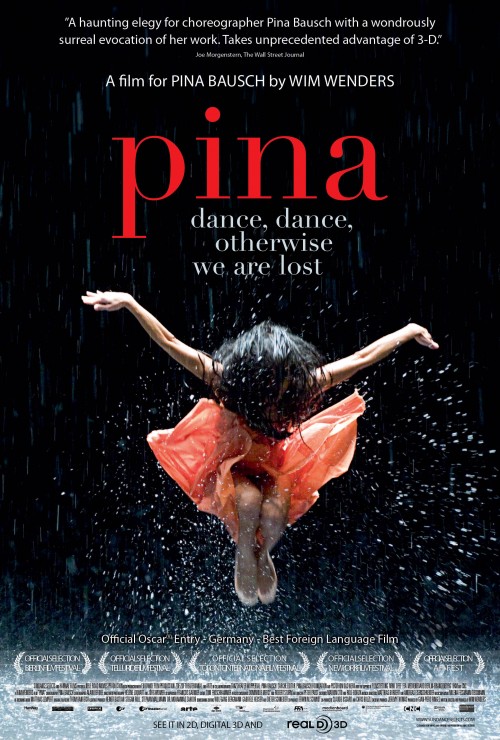Pina (Bausch) The Movie — Cults and Transcendence (??) — Selling Out (??)
*******
Pina, the movie, Wim Wenders’ movie, about Pina Bausch, the German dancer and choreographer, is a beautiful and strange thing about which much has been said– and I’m going, here, to put my 2 cents into the conversation regarding the inhumanity of the “characters” in the performances; the heavily-emphasized “cult” aspect of Pina and her dancer/followers; and, lastly, the fact that the movie, for all its strangeness, all its ability to jar, alienate and electrify seems to be a tamer and lesser version of what it could have been.
(It’s worth noting, also, that Pina died, unexpectedly, two days before production was set to have begun).
Inhumanity:
Café Müller”, “Le Sacre du printemps”, “Vollmond” and “Kontakthof” are the movie’s dancing core, chosen, reportedly, by Wenders and Bausch together. These pieces are augmented by dance solos by many members of Bausch’s Wuppertal ensemble. And when critics talk about the performances, the performers, etc, they invariable talk about “love”, “male/female situations”, “violence”, etc, etc. And there’s truth to all this. But all the dance “characters” in Pina, the movie, are inhuman, or at the most, barely, barely human. Always (even, but less so, in the joyous and upbeat Vollmond) the characters come off as mechanical, herky-jerky, strange-eyed, entranced, ghostly, pecking, not kissing, like birds, things reduced to primitive, animal states; machines, ghostlike, jerked about on the stage, into and away from each other, slaves to their components, their elements, to what their DNA’s whispering inside and through them.
The situations are male/female but it’s not the public male/female world and atmosphere we’re used to. (Perhaps we recognize them only behind closed doors, in the bedroom, etc, but certainly not in public, not in polite, civilized company). Pina’s characters that we encounter, completely human in form, but acting so strange and alien and animal, shock and electrify us as we’re forced to meet them on their terms, melting slowly (if we submit) into the worlds that Pina made: great worlds filled not with Shakespeare’s Romeo and Juliet, MacBeth and Lady, Willy and Linda Loman, etc, but instead with stilted, rendered vehicles and vessels of sheer chemistry, distorted, stilted machines, automatons, short-circuiting frighteningly and sometimes joyously in the elaborate and sometimes awkward settings Pina devised to further entrance us.
Selling Out/Drawing In Her Claws:
As bewildering and pleasing as the movie comes across (especially to the uninitiated) it is an older, toned-down Pina vision and approach that we are treated to. The mix, really could have been more interesting and pleasing even. What we get is wonderful, but it’s a safer and more commercial Pina. In its generally glowing obituary, The U.K. Telegraph notes that “as her fame grew, Pina Bausch’s creations increasingly drew criticism for their Grand Tour aspect,” and, indeed, Pina the movie, does have commercial elements to it, (still charming, sometimes pretty, and mostly pleasing) that are reminiscent of, for example, Cirque du Soleil.
In “Kontakthof” we do get creepy, awkward and discomfiting, interactions between a group of males and a single female that hint and imply/suggest gang-rape but these pale in comparison with the hyper-aggressive sexual violence depicted in earlier performances (for example a much more disturbing and graphic scene of gang-rape in her version of the Brecht/Weill opera “The Seven Deadly Sins.” A performance of this sort, though, was liable to be written off as a “pornography of pain”– Arlene Croce).
Also, where are all the animals that were such a vital element of Bausch’s middle and most aggressive and jarring phase? (all we get is a Hippopotamus cameo and a few moments of a little jumping circus dog). And where, also, are the more visceral, affective and controversial parts of Nelken, one of her most famous and archetypal works? Nelken, with is snarling attack dogs and Nazi overtones?
Pina was radical, fierce, independent, and something of a Cult figure presiding over a self-contained world in Wuppertal, but she was also shrewd, circumspect, and in order to cultivate larger and larger audiences, in huge pageantry far away from Wuppertal, decided to be more commercial, less shocking, and “drew in her claws.” (phrase borrowed from Luke Jennings, in The Guardian. Luke, interestingly, uses the term to describe Pina as she embarked on “a period of more or less conventional choreography” during her early years at Wuppertal, because her initial piece, Fritz, had not been well received. Audience members, reportedly, walked out mid-performance and fruit was thrown at the dancers.)
Cult:
The movie (performance documentary) that Wim Wenders gives us is very much a portrait of a cult leader and her following. And some people find this repulsive. But, long before the movie went into production Pina Bausch and her Wuppertal world already had something of a “cult” reputation. Sylvie Guillem, great French Ballerina, never worked for/with Bausch but when asking about the possibility she said she thought it would be “like joining a cult.”
Here are just a few examples of what Pina’s dancers have to say on screen:
“Pina was a painter. She constantly questioned us. That’s how we became the paint to color her images.”
“Pina had the most penetrating eyes. No one has ever read me that way. Everything I tried or pretended to be disappeared under her gaze.”
“She was aware of us all. She saw everything. Even with closed eyes.”
“New in the company I didn’t yet grasp how Pina worked. And she didn’t explain it. I was lost. Until I realized I had to pull myself up by my own hair.”
This last quote suggests a kind of austere Monastic environment where the disciples must patiently wait, striving for a moment of “enlightenment.” But there’s a violence to this enlightenment and the “constantly questioned us” suggests a more traumatic, hands-on imposition of will and vision. A will and vision that seized on and demanded exaggerations of personality ticks, quirks, and physical strangeness: a Pina who “saw everything, even with closed eyes” seems to have exerted enormous pressure (both passively and actively) on her dancer-followers.
Perhaps Wim Wenders purposefully chose such quotes to over-weight the cult aspect because he thought that would make for a more interesting movie. But, since there was a real cult aspect to Pina and her dancer/followers (Pina, in Wuppertal, did, in actual fact, preside over a relatively self-contained world. She and her dancers all lived in the same, relatively isolated, obscure town, working tirelessly to create something all their own. Many, supposedly, found themselves there, in that different, world, under her all-seeing eyes) it makes sense that just about anything they would say would reflect this. Even their expressions are creepy. Really, they look like creatures just emerged from a compound in which they’d spent the majority of their lives. Their adult lives at least.
Ismene Brown, in her review on theartsdesk.com, finds this all “magnified by Wenders…odd, alien and repellent.”
I don’t find it repellent at all. It excites me. Excites me that Pina was able to create such worlds and was able to do it so completely and so successfully. So what if it was “like a cult”? Or, actually, a cult even? Cults aren’t so special or weird really. They’re just less successful (or smaller) versions of what everyone’s a part of: ie, systems of leaders and followers. Leaders who impose rules, fashion and culture – And the rest who follow. And most people are meant and want and need to follow.
Barbara Bogaev, in HiLoBrow, seems more pragmatic, conceding the cult elements of Pina and her dancer/followers, but, awed by the performances (“you left the theater convinced that you could split atoms”) asks the question “But can you achieve transcendence without fanaticism?”
It’s a great question and I’d like to think (or would I??) that there’s a smart and true “yes” out there. But is there?
Conclusion:
Pina’s a wonderful movie. But it’s not the movie Pina envisioned (I can’t imagine her being ok with the cult aspect so heavily dramatized). And it’s not exactly what I think it should have been: more interesting, complicated and intense with more animals, unrestrained violence, and more direct, in your face “pornography of pain.”
But, again, it’s strange and beautiful and jarring. A delight for dance-world people. And a great taste for those who aren’t.
Tags: pina bausch, rauan movie review, wim wenders






YES. I want this film to be more attended to. Thanks for this, RK.
thanks, Ken! — also, was that you asking Tao a question on Youtube of his reading and Q & A the other day (Skylight?? or something like that) ?? …
yep
Rauan did it make you dance, is the question I have for you.
I’m curious what “cult” means in this context. Is it mostly the ‘leader/follower’ thing? –commitment to one person’s vision being the cost of membership in the community? fanatic devotion to that one leader’s command of the process, so that the collaboration among a group of people consists of everybody but one person committing to being a tool in that leader’s hands?
It doesn’t seem that uncommon in dance. Wasn’t Balanchine a ‘cult leader’ in this sense? Were/are the groups around Cunningham, Tharp, and Morris ‘cults’? Is a taiko dojo a ‘cult’?
Maybe Bausch was a devious, malignant person–which ‘cult’ connotes, to me: mind control–. Or just a charismatic person other artists were pleased to devote themselves to, for the value of their working together?
thanks for commenting, asking questions,….
Wiktionary defines “cult” as
(offensive, derogatory) A group of people with a religious, philosophical or cultural identity sometimes viewed as a sect, often existing on the margins of society or exploitative towards its members.
so most of this seems to fit… and it’s strange, because if you take the “exploitative” clause out (which after all comes after an “or”, because this definition shouldn’t necessarily and automatically lead to “offensive” and/or “derogatory.” i guess people don’t like strangers.
& i don’t know so much about devious or malignant but i think the “cult” feel that Pina’s dancers give off (so devoted, so dependent-seeming) freaks people out, because it feels so alien. so strange. and people “on the margins” (strangers) generally aren’t judged favorably.
most strangers, at the end of the day, are pretty much like ourselves. we just don’t see it. ie, just because we aren’t on the “margins of society” doesn’t mean we aren’t living in a cult system.
i dunno.
since i quit drinking, Greg, i don’t dance at all!
tinyurl.com/l3cselt.
[…] to write a Godless sort of language and landscape that I envy tremendously. When I saw the movie Pina I thought about Gary’s poetry. Gary is also an Artist. Kind of like Michaux. But different. I […]